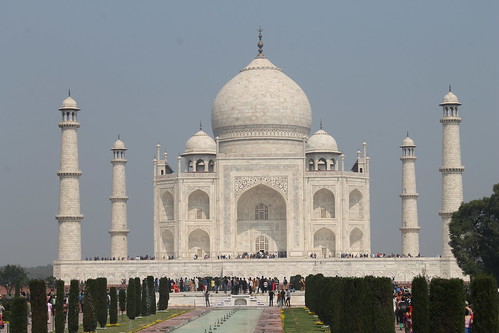
Love inspires grand monuments and grand statements. Here, the Indian poet Rabindranath Tagore was waxing poetic about the beauty of the Taj Mahal. I’ve read this quote countless times in guidebooks and introductions, and you know, that’s quite a statement. When we planned to visit India, I knew that we needed to go see the Taj. Not quite because I was dying to make the trip to Agra, but more because I knew we would regret visiting India and not seeing it in person.
The Preparation
Knowing it would be a difficult trip to plan, we made no other plans for our five days in Delhi. After some online research, I was overwhelmed by the logistics of taking a train to Agra and transportation from there to each of the sights in the city, so I suggested to Steve we try a tour group. We checked out a few places on the Main Bazaar that advertised day-trips to Agra. One place suggested a bus trip (leaving at 6 am, coming back at 11:30 pm) for 500 rupees a person, which sounded a little too cheap to be good (less than $10 USD per person, really?).
We also stopped by the travel desk at our hotel to inquire, and they suggested we hire their car and driver to visit three different sights in Agra, which would be more of a 12-hour journey for approximately 6000 rupees ($100 USD). We went back to do more research, but barely an hour later, the travel desk called our room to let us know there were two other travelers also hoping to go to the Taj tomorrow, so the price was just halved the price to 1500 rupees per person. After a hurried conference, Steve and I decided to go along with this unexpected opportunity.
The Journey
The next morning, we set off at 7 am with two Germans from our hotel (named Sven and Stefan) and our driver, a guy who looked no older than me, named Kumar. It was an achingly long car trip (nearly four hours) in a very small car. I’m used to sitting in the middle seat because I’m the smallest, body mass-wise, but between all the swerving, honking, and near-misses with pedestrians and auto rickshaws, I wished I had a seatbelt very badly.
Traffic here is as chaotic as it is in China, but there are practically no sidewalks, and more types of traffic intermingling at similar speeds, like the cycle rickshaws and auto rickshaws, not to mention scooters and bikes and pedestrians. Dotted lines are mostly ignored, traffic lights not honored unless you’re in a big city, and honking between cars is more like a call-and-answer or Marco-Polo to let each other know how close your vehicles are. Kumar readily told us that his family didn’t want him to be a driver because it was so dangerous. For most of the way, we were on the Yamuna Expressway, a newly built highway that was on par with the U.S. interstate system. Several people, including Kumar, sounded very proud of the expressway, but India has a long way to go before its driving becomes world-class. There were lots of signs all over the highway to remind people that they should only pass on the right, and indicate their passage with the turn signal as well as high beams. From what we saw, these signs were sadly necessary!
The Arrival
Kumar dropped the four of us outside of the West Gate, since cars were not allowed inside. Ever since they discovered that pollution was actually discoloring the Taj back in the early 2000s, cars have not been allowed within 500 meters. We walked inside, promising to meet him in two hours, which was our first mistake, because it proved to be just shorter than we would have liked. Inside, we were immediately greeted by touts and salesmen hoping to persuade us to jump on small auto rickshaws or camel-drawn carts for the nearly kilometer-long walk to the West Gate proper.
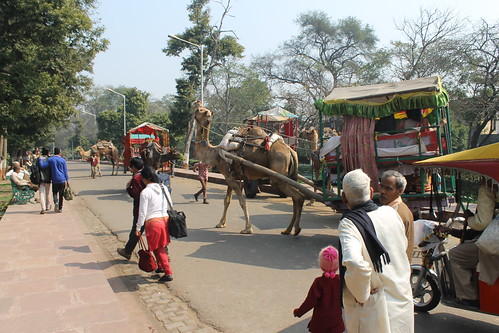

We found the gate easily enough, and the tourist line was much shorter, though much more expensive (750 rupees in total, in contrast to 20 rupees for the locals). There was a long, winding security line. In India, women and men queue separately, and women get to be screened by female security guards in a curtained off box or shed, as I’ve experienced at the Delhi Metro and also at the airports. After we got inside, we made our second mistake, which was to buy an audioguide. It cost us a little over 200 rupees to get an audioguide in English as well as two headphones for both of us. By the time we actually found ourselves within sight of the Taj, we had used up a whole hour. The pace of the rest of our walk through was a little too fast, and we only had time to listen to a few stops, which were pretty informative.
The Tomb

In person, the Taj is very striking. Some larger-than-life art or public figures (like the Mona Lisa or Jon Stewart) are smaller than you imagined, but the Taj is huge and picturesque. I found it most beautiful when viewed from far away, either when you first enter, or from across the river at Agra Fort. It looks delicate, and very fairy-tale like, and I thought it would just be enough to look at it for a long time. Up close, it is still pristine, but loses some of its ethereal charm. You can see the details of the Arabic quotes from the Qu’ran framing the marble doorway, surrounded by beautiful flowers in pietra dura, the art of inlaid precious stones in marble to create patterns. The red is carnelian, the green jasper, and the black Chinese jade. I was impressed by the huge amount of detail and care taken with these flowers, some details more slender than my finger.
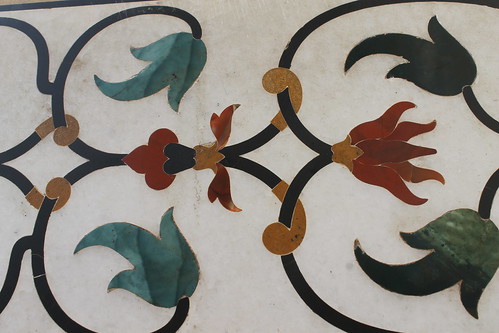
The appeal of the Taj is so simple — its perfect symmetry on every side, a cube building, and entirely constructed in white marble. We took a long time looking at it, and could have spent more investigating the mosque complex to its left and the other tombs to its right, but we had to make it into the interior of the tomb, which is nothing to write about, and then back out, which took a good fifteen to twenty minutes.
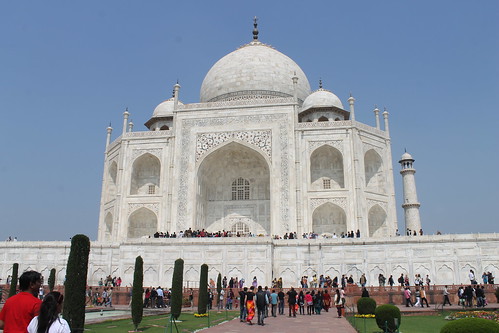
Agra Fort and Baby Taj
We had apparently come to Agra with a bunch of indefatigable Europeans, because the Germans were all for going on to Agra Fort, only 2 km away, without any lunch, and it was already 1 pm. Oh, well. We followed. Before this, the most I knew of Agra Fort was from “The Sign of Four” of Sherlockian fame. It turns out that Agra Fort is to the Mughal emperors of India what the Forbidden Palace in Beijing was to the Qing Dynasty, except differently preserved. The latter has a lot more objects and interior decorations, but looks more fake. Agra Fort’s architecture looks more original and genuine, if a bit worn from military occupation by the British. Most of Agra Fort is constructed from red sandstone and white marble. It stands along the Yamuna River, and offers a dreamy view of the Taj.
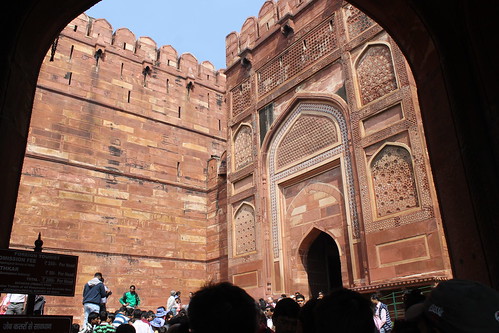
Shah Jahan, the Mughal emperor who constructed the Taj Mahal to commemorate his wife Mumtaz Mahal, was deposed by his son, and spent the last eight years of his life a prisoner in Agra Fort. It was rumored that he died in his rooms in a tower from which he could see the Taj.

Steve and I both loved the Agra Fort, which was grand and very stately. The combination of red sandstone and creamy marble and extreme symmetry was really compelling. Kumar told us it would only take an hour, but we were content to spend the whole hour and a half strolling around the grounds.
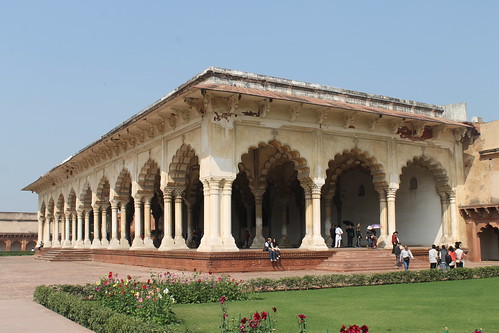
After a hurried lunch at a joint called the Quality Restaurant, where they served the most un-quality mutter paneer (peas and cheese) I’ve ever tasted, we went to the Baby Taj for an hour. Baby Taj is a shorter and easier name than the Tomb of I’timad-ud-Daulah.
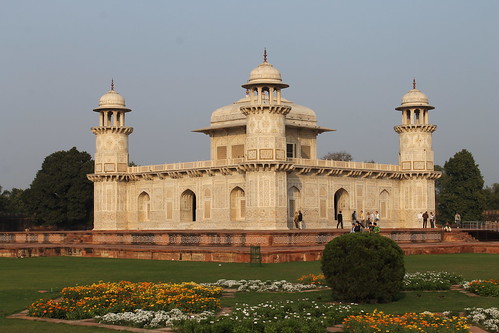

It is the tomb of the father of Nur Jahan, wife of the Mughal emperor Jehangir, and holds many of Nur Jahan’s family. As an example of architecture, the Baby Taj is widely acknowledged as the prototype for the layout of the Taj Mahal, as well as its use of white marble and pietra dura. But whereas the Taj is immense, the Baby Taj is much smaller, on a human scale, and intricately detailed. The entire structure is covered with pietra dura in flowers, geometric patterns, and vases.

It was incredibly beautiful at dusk, and the gates were also much more elaborately adorned with white marble in red sandstone. I took about a billion pictures because I loved the contrast in color and texture between those two materials.
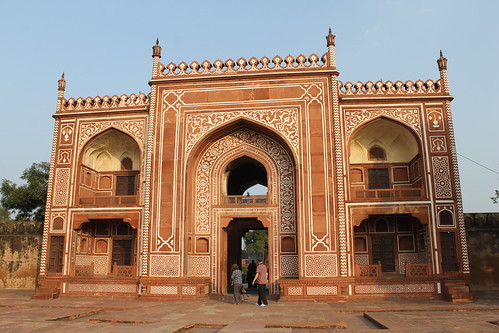
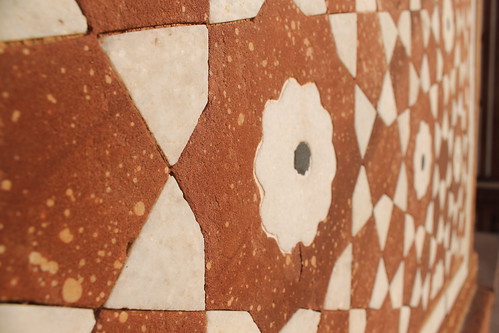
The Wrap-Up
We drove back to Delhi, and I slept most of the way, exhausted. We got in around 8 pm, exactly 13 hours after we’d left. It was an incredibly tiring day-trip, which I hope never to repeat again. If we could do this over, I’d fix those two mistakes at the Taj, and try for two days, so we could visit the city of Fatepur Sikhri, which is near Agra. Our funniest memory of the day came from a tour guide who was trying to persuade us to use him instead of an audioguide, because “the Taj Mahal is all about feelings, and you cannot have feelings with the audioguide!” True story.
People were also trying to sell us the most asinine things, like the Taj in a snow globe. Like, what? Agra is also not the most endearing place. Restaurants all charge sky-high prices, twice to three times what they do in Delhi, for very bland tasting food. And that’s just what we were exposed to when we actually had a car and driver at our disposal. This was definitely one of those parts of our trip where we were glad to have thrown some money at it to make it easier.
Overall, I am glad we went — this wasn’t our most pleasant experience in India by a long shot, but we saw some of the most beautiful architecture that we’ve encountered in our lives, and I’m going to remember that for a long, long time.
Connie
So beautiful!
<3!
What I would give for a Taj in a snow globe!
(Better even than the one I’ve seen from Memphis with Elvis and Jesus holding hands – in the snow.)
Beautiful descriptions – I’m really enjoying your writing! And the photos are great!
Oh, Stuart, now I wish I’d bought some hokey souvenirs just to give people a laugh back home. Elvis and Jesus sounds pretty good, though!!